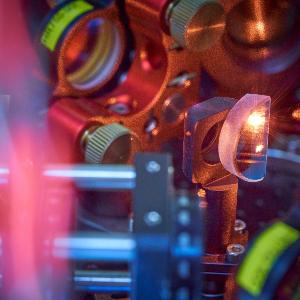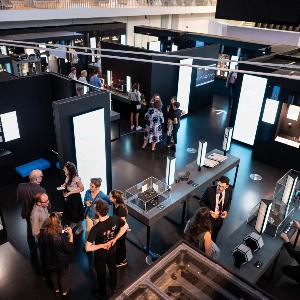MCQST Cluster of Excellence: A Strong Ecosystem
22 May 2025
How a group of Munich quantum scientists built a globally one-of-a-kind research network
22 May 2025
How a group of Munich quantum scientists built a globally one-of-a-kind research network
Here begins the tale of a Munich grassroots movement. Over a decade ago, a handful of Munich quantum physicists came together with the aim not only of understanding the mysterious phenomena of the realm of the tiniest particles, such as entanglement, but also of rendering them useful for practical applications. Immanuel Bloch is one of the founders of this movement.
Speaking in his office at the Max Planck Institute of Quantum Optics (MPQ) in Garching, the LMU physicist and MPQ Director recounts how he and his fellow pioneers began to delve into the world of quanta together “without any external help.” The loose alliance would eventually become the Munich Quantum Center and subsequently evolve into the successful Cluster of Excellence Munich Center for Quantum Science and Technology (MCQST), which has now been granted funding by the German Research Foundation (DFG) for a further seven years.
Our approach of building a strong ecosystem in Munich paid off right from the start - we have a close community that supports each other and values its roots.Immanuel Bloch

Detail of an experimental setup from a quantum laboratory at LMU | © Jan Greune / LMU
The fact that this decision was made in the international year of quantum 2025, one hundred years after the formulation of quantum mechanics in 1925, gives the DFG funding approval a deep symbolic resonance with the Munich quantum researchers. “Our approach of building a strong ecosystem in Munich paid off right from the start - we have a close community that supports each other and values its roots,” says Bloch. “For a center that continues to grow, this is the foundation for success.” As if to vouchsafe his words, a large portrait of his doctoral advisor, Nobel Prize winner Theodor Hänsch, hangs on the wall of his Garching office.
Like its predecessor, the Cluster of Excellence MCQST-2 will seek to investigate the scientific foundations of complex quantum systems, enabling a broadening of the base for quantum technologies 2.0, as Bloch likes to call them. The cluster will be structured into six research areas going forward, ranging from basic research to applications. Quantum information theory is equally as important as quantum cryptography, the quantum simulation of solid-state systems, and the development and researching of novel quantum materials, quantum sensors, and the building blocks of a quantum network. “The cluster really does cover all areas of quantum science, which is unique in the world. This is the foundation for true progress, as we are building on a strong ecosystem of all partners involved,” says Bloch, who is a spokesperson for MCQST alongside Barbara Kraus from the Technical University of Munich (TUM) and Ignacio Cirac from the Max Planck Institute of Quantum Optics.
In the coming years, the focus will be on strengthening those specific areas that have “the greatest potential for new developments,” says Bloch. A key role will be played by welcoming many new colleagues as well as early career researchers into the ecosystem, who will enrich the research done here by adding their respective fields of expertise and thereby enabling MCQST to undertake innovative projects. “The excellence of new members joining the cluster has always been a top priority,” emphasizes Bloch. Outstanding TUM scientists have also joined the cluster, such as the new co-spokesperson Barbara Kraus, a specialist in quantum information theory, Stefan Filipp, an expert in superconducting circuits, and Peter Rabl from the Walter Meißner Institute of the Bavarian Academy of Sciences and Humanities, who works on quantum networks for secure communication.
MCQST has even been able to attract two Leibniz Prize winners to LMU in recent years. Peter Hommelhoff brings with him pioneering research from Erlangen, positioned at the interface of laser, solid-state, and quantum physics. His team explores the wave and particle properties of electrons in ultrafast processes at the surface of and within nano-objects. This enables the researchers not only to generate quantum optical systems - laying the groundwork for a quantum electron microscope - but also to manipulate and entangle electron wave packets, opening the door to investigations of quantum mechanical many-body effects.
Dmitri Efetov, meanwhile, researches the properties of ultrathin 2D materials, such as bilayer graphene twisted at the “magic angle” of 1.1 degrees. This represents an entirely new class of quantum materials. “His work aligns extremely well with the approaches we’re pursuing in our research group,” notes Bloch. And more broadly, it complements MCQST’s established focus on quantum simulation.
Bloch himself is a quantum physicist specialized in quantum simulation - and is one of the founders of the field. His research aims, amongst other things, to deepen our understanding of solid-state phenomena such as magnetism and superconductivity. He makes these investigations using experimental model systems consisting of ultracold atoms trapped in artificial “crystals of light”. With these optical traps, his team is able to simulate many interesting structures commonly appearing in solids. Notably, studying the behavior of such many-body systems is in many cases virtually impossible with the use of classical numerical calculations, even with the processing power of the latest supercomputers. The simulations also allow researchers to observe physical phenomena using methods that were previously unimaginable. The progress in this field has been remarkable, as evidenced by the many high-profile publications from the various research groups involved.
Indeed, the raw figures of MCQST speak for themselves. The current Cluster of Excellence has produced over 1,500 publications, many of them in first-rate scientific journals. In addition, MCQST members have secured no fewer than 29 ERC Grants by the European Union and include two Leibniz Prize winners, two Clarivate Citation Laureates, and ten Humboldt award winners. Yet, Bloch and his colleagues are not resting on their laurels. “We want to maintain the positive spirit and the sense of community we’ve had from the very beginning - and carry it forward into the next phase of the cluster,” says Bloch.
Our master’s program in quantum science and technology (QST) is a huge success.Immanuel Bloch
Building a strong culture of excellence in the community remains key to the future success of the cluster. “How do we convey the enthusiasm and knowledge we have to the next generation – and deepen it?” asks Bloch. A pioneering response to this question can be seen in the enormous effort that is being made to introduce specifically talented early career researchers to cutting-edge research. “Our master’s program in quantum science and technology (QST) is a huge success,” says Bloch. It has become one of the largest physics degree programs in Germany. Although the program was launched only as recently as 2020, it currently ranks sixth nationwide. “We’re trying to establish innovative support programs that span the entire educational journey - from bachelor’s students, to master’s students, graduate training, the post-doc phase, all the way through to professorship.”
In addition to expanding international research collaborations like CalBay (between California and Bavaria), Bloch is also focused on attracting talented early career researchers from abroad. One avenue is the current open calls at the graduate school, which welcome applications from doctoral students and postdocs across all relevant disciplines. More than 300 applications are being read and evaluated at this moment. “These competitive calls increase quality, attract a diverse talent pool from all over the world, and help us find the very best,” says Bloch. “We thrive on the quality of our applicants.”
At the same time, Bloch emphasizes that a dynamic network like MCQST is always looking to offer current topics that inspire the next generation and have potential for future research areas and applications – error correction for quantum computers, for example, or the development of novel concepts for superconducting and atomic “qubits”, potential processing units of a quantum system. “That being said, we want to focus on foundational research in the cluster,” says Bloch, “and leave the domain of quantum computing applications more to Munich Quantum Valley,” in order to distribute work in the quantum ecosystem in the best possible way. “This does not mean, however, that researchers are not available to start-ups as scientific advisors. For instance, I myself support the spin-off ‘planqc’ in this way,” says Bloch.

In collaboration with the Deutsches Museum, a partner of the MCQST, the researchers have developed the “Light and Matter” exhibition in recent years, which is set to become part of the permanent exhibition at the renowned technology museum in 2028. | © Mikka Stampa / MQV
The external impact of such a large network, which, as Bloch repeatedly notes, “also benefits from public support” (i.e., from taxpayers’ money), is of great importance as well. Outreach isn’t just something MCQST emphasizes during the year of quantum 2025; it’s a lasting commitment. In partnership with the Deutsches Museum, MCQST developed the “Light and Matter” exhibition in recent years. Starting in 2028, this will become part of the museum’s permanent collection. Meanwhile, the PhotonLab at the Max Planck Institute of Quantum Optics in Garching was created to engage school students. The staff there continuously design new experiments in quantum and laser physics and organise demonstrations of them for school classes. “Their programs are always fully booked,” says Bloch. “Initiatives like this depend on the dedication of forward-thinking individuals—people like Silke Stähler-Schöpf, who runs the school lab.”
After all, planting seeds of knowledge isn’t limited to research. And that’s likely what Immanuel Bloch had in mind when he spoke of grassroots at the beginning of our conversation. A true community is built not primarily through funding—but through enthusiasm for a shared vision.